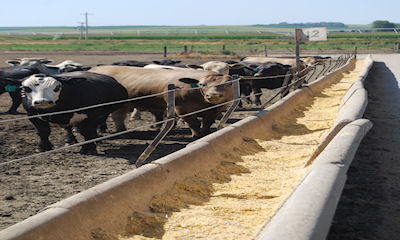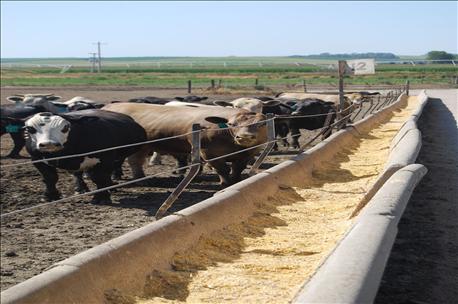July 22, 2015

So far cool evenings have help cattle handle the hot, humid weather during the day. That may change in the next few weeks and it is best to be prepared to help cattle cope with the stress.
Gerald Stokka, North Dakota State Univesity Extension livestock stewardship, and Carl Dahlen, NDSU Extension beef cattle specialist, offer this checklist:

Feedlot cattle are at high risk from heat stress.
Monitor temperature and humidity forecasts. Pay attention to long- and short-term weather forecasts and have a copy of the temperature humidity index chart readily available. Determine the potential risk threshold and be prepared, even if the risk is several index units away.See the USDA heat stress forecast tool at http://www.ars.usda.gov/npa/marc/heatstress.
Identify animals that are most susceptible to heat stress. They include feedlot animals closest to the market endpoint, very young and very old animals, and those with dark hides.
Give each animal access to at least 2 inches of linear water trough space in a pen. This means that in a pen with 200 animals, you need to have 400 inches of linear water space. If your cattle have access to only small water troughs, add temporary space for additional water access during the summer.
Evaluate your water supply lines and ensure you have sufficient water pressure and flow capacity to keep troughs full during times of peak water consumption.
Move the animals' feeding time to late afternoon or evening. This will allow rumen fermentation to take place during the cooler night temperatures, and it will increase the cattle's lung capacity during the hotter daytime temperatures.
If feeding once daily, consider moving feed delivery until the afternoon. If feeding multiple times daily, consider feeding a small meal in the morning and a larger portion of the diet later in the afternoon. Decrease the amount of feed offerings during and for several days after heat stress.
~~~PAGE_BREAK_HERE~~~
Provide adequate air movement. Remove unessential wind barriers (portable wind panels, equipment, weeds and other objects) to promote better air movement. Having mounds in pens gives cattle more elevation and possibly access to a microclimate with more wind.
Cool the ground and the cattle gradually. Sprinklers cool the ground cattle are lying on as much as they cool the cattle. Set up sprinklers well in advance of anticipated heat stress because cattle take time to adapt to changes. Use the sprinklers during mildly hot days so cattle become accustomed to the sights, sounds and the cooling effects of the sprinklers. An alternative to sprinklers is running a hose into pens to wet the ground where cattle will be lying. Run the sprinklers or wet the ground before the day's peak temperatures.
Be aware of the droplet size of water coming from the sprinklers. The goal is to have large droplets of water. A fine mist likely will make the pens even more humid and contribute to greater heat stress.
Provide shade if possible.
Add light-colored bedding (straw or corn stalks) to reduce the temperature of the ground on which cattle are lying. Apply bedding to the tops of mounds and other areas likely to have wind. Also, wet the bedding before or shortly after putting it out.
Control flies as much as possible because hot cattle tend to bunch together and flies will add to the stress of hot days.
Do not work cattle during temperature extremes. If working cattle is absolutely necessary, keep working time as short as possible, use calm-animal-handling techniques to minimize stress related to handling, and consider running smaller groups through the facility or into holding pens. Provide sufficient water in holding pens. Get started as early in the morning as daylight will allow. Do not work in the evening after a heat-stress day; cattle need this time to recover. Reconsider the necessity of working cattle during these periods; postpone or cancel some working events.
For more information about dealing with heat stress on beef cattle operations, see an NDSU Extension publication at http://tinyurl.com/beefheatstress.
Source: NDSU Extension
You May Also Like




